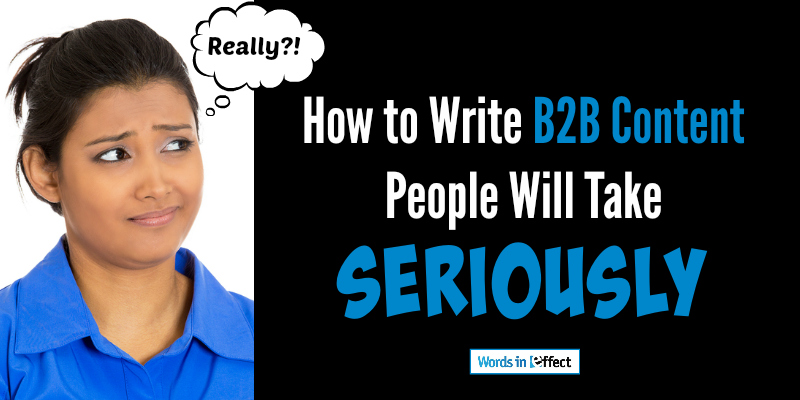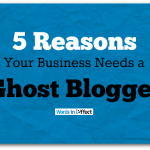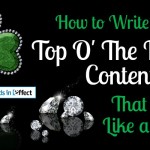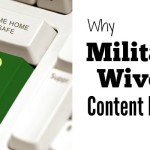
Have you ever read B2B content you didn’t take seriously?
Of course you have.
It could have been the little things, like misspelled words or homophone confusion.
It could have been bigger things, like lackluster visuals or confusing jargon.
Or it could have been big, nasty things, like:
- a topic that’s been beaten to death;
- a sales pitch disguised as helpful or newsworthy content; or
- an argument that lacks meaningful support.
Now, let’s turn the tables. Has your content ever fallen short of your ownhigh standards? Of course not (wink, wink, nudge, nudge).
Cursory Content Tells Audiences, “You’re a Low Priority.”
If you’ve ever hit “publish” just to get a few points on the board, you’re not alone.
We content creators all want meaningful engagement. We take pride in showcasing our expertise. We delight in sharing our passion for solving customers’ problems. But it’s really hard to carve out time for a five-star blog post or presentation, let alone a sustained creative effort.
So, what’s the answer? Should we eke out whatever we can, as quickly as possible?
Here’s the problem with that approach. When marketers don’t take content writing seriously (“We don’t care enough to do content well”), audiences don’t take brands seriously (“They don’t care enough to serve us well”).
Nothing lost in translation there. Your prospects are getting the message, loud and clear.
5 Critical Do’s for B2B Content Marketers
Here’s a handy list, along with some inspirational resources, that can help guide your future content efforts.
#1: Be Bold. Be Brazen!
You’re a disruptor at heart. You know where your industry is failing customers, and you have the formula for change. You’ve got the talent, capabilities, and success stories to back up your brand promise.
But does your content reflect all that? Is it bold, just like your brand? Or is it safe and boring?
I’ve encountered few marketers more brazen than Scot McKee of Birddog B2B. I love his brutal honesty. It’s clear where his passion lies: helping brands smash through the clutter. Check out“The Long Talk,” Scot’s take on the myopic thinking that limits B2B brands’ creative potential.
#2: Make Them Laugh (with You, not at You).
I’ve written before about the 5 key benefits of using humor in B2B content. One thing I would add this time around: People love sharing funny content. All people. Yes, even the B2B buyers you’re targeting.
If you understand the irritations that plagueyour buyers, you have all the material you need. Laughter is terrific medicine; by making audiences laugh, you’re providing welcome relief. You’re also demonstrating your empathy, which wins people over fast.
Think you have a boring brand? Can’t think past sell sheetsand white papers? Read Humor and B2B Marketing: A Love Story by Ann Handley.
#3: Be a Friend, Not an Entity.
A warm, conversational tone. Relatable stories and experiences. What’s not to love?
When we reveal our inner selves in our content, we’re touching human beings who happen to be decision makers, not the other way around. B2B marketers who dare to be authentic and vulnerable are still a rare breed. Thus they’re more successful at generating interest, forging connections, and building trust.
Here’s a great example of authentic content: What If PR Stood for People and Relationships? a manifesto for building relationships in the digital era, a highly successful eBook from Cision (with Brian Solis of Altimeter Group).
#4: Flex Your Intellectual Muscle.
Everyone wants to be a thought leader. Few, however, accomplish this goal. To have any hope of success, you have to delve deeply into the issues your customers and prospects face.
Take a look at the content you’re producing, and ask yourself:
- Are we merely providing data, or are we using it to tell a larger story?
- Are we challenging conventional wisdom in our industry?
- Are we simply defining our niche, or are we communicating a vision?
Dr. Liz Alexander, cofounder of Leading Thought, helps companies around the world become industry-leading influencers. You can read my interview with her about what thought leadership is (and isn’t), or you can read her post “8 Reasons You Really DON’T Want to Be a Thought Leader.”
#5: Edit Like a Maniac. And Not Just for Errors.
Maybe you’re like me: you edit as you write. But that’s not good enough. Make several passes after you think you’re satisfied. Scrutinize every detail.
- How’s your hook? Could it be simpler? Funnier? More intriguing? Give audiences a reason to care about what comes next.
- Spelling, punctuation, and grammar—yeah, you know the drill.
- There can be no doubt about the use of a word. If you’re the least bit hesitant, choose a different word.
- Language must be clearandconcise. Trim the fat, then trim again.
- Flow is everything. Give audiences the gift of an effortless read. If anything trips you up—a phrase, a sentence, a paragraph, the way you’ve organized your thoughts—do whatever it takes to get the flow just right. This could require shortening, rewording, or ditching a sentence. Breaking up or reordering paragraphs. Or scrapping an entire section altogether. (Painful, yes. But content that bombs is 10x more painful.)
Copyblogger has a wealth of great posts on this subject. Here’s one by Stefanie Flaxman, Copyblogger’s editor in chief: “15 Copy Editing Tips That Can Transform Your Content into Persuasive and Shareable Works of Art.”
What Critical Do’s and Don’ts Would You Include?
When you’re out there consuming content, what makes you roll your eyes? Slap your forehead? Wish you could get those precious minutes back?
I’d love to know your thoughts on this topic, this post, or anything else related to B2B content writing. Let’s start a conversation in the comment section below.

Since 2001, Becky Tumidolsky has written awareness-building content for B2B brands and their discerning audiences. Her work has appeared in leading publications such as Forbes, U.S.News & World Report, Bloomberg Markets, Newsweek, and Inc. as well as corporate blogs, websites, white papers, and other content assets.
Becky loves writing fluid, error-free prose. She’s even more passionate about building the foundation for her work—uncovering core brand distinctions, framing them thematically, and developing fresh, compelling narratives that advance corporate strategies.
Follow and connect: Twitter| Google+| LinkedIn| Facebook





Leave a Reply